Eumorpha vitis vitis
|
|
Updated as per
AN ANNOTATED CHECKLIST OF THE SPHINGIDAE OF BOLIVIA, October 2007
Updated as per http://www.pybio.org/MACROGLOSSINAE.htm (Paraguay), October 2007
Updated as per L.O.L.A. publication Hawkmoths of Argentina, More, Kitching and Cocucci, 2005, November 2007
Updated as per Bilogical Diversity in Belize, November 2007
Updated as per The Known Sphingidae of Costa Rica, October 2007
Updated as per personal communication with Ezequiel Bustos (Aguas Blancas, Salta, Argentina, 405m); December 2009
Updated as per personal communication with Patrick Demez (Ica, Peru, January 23, 2010); February 3, 2010
Updated as per personal communication with David Morimoto (Starbroek market area, Georgetown, Guyana, January 17, 2011); February 1, 2011
Updated as per personal communication with Brian Fletcher (Urraca Lodge, Jorupe Reserve, Loja, Ecuador, January 30, 2014, 500m); March 12, 2014
Updated as per personal communication with Sergio D. Ríos Díaz in CATÁLOGO DE LOS SPHINGIDAE (INSECTA: LEPIDOPTERA) DEPOSITADOS EN
EL MUSEO NACIONAL DE HISTORIA NATURAL DEL PARAGUAY; sent to me in July 2014 by Sergio D. Ríos Díaz.
Updated as per personal communication with Joanna Rodriguez Ramirez (Entre Rios; Argentina), January 21, 2015
Updated as per personal communication with Ezequiel Bustos (Shilap revta. lepid. 43 (172) diciembre, 2015, 615-631 eISSN 2340-4078 ISSN 0300-5267), January 4, 2016
Updated as per personal communication with Magno Marcio Nascimento (Matões Maranhao, April 2, 2016); April 3, 2016
Updated as per personal communication with Andre Netto (Meruoca, Ceara, Brazil, March 7, 2018), March 9, 2018
Updated as per personal communication with Francierlem Olveira (Extremoz, Rio Grande do Norte, Brazil, August 23, 2016), May 18, 2018
Updated as per personal communication with Erica Regina (Tucuruí, Para, Brazil, January 14, 2019); January 15, 2019
Updated as per personal communication with Paulo Renato Huppes (Gravatai, Rio Grande do Sul, Brazil, June 2, 2019); June 3, 2019
|
Eumorpha vitis vitis
you-MOR-fuhMVEE-tiss
(Linnaeus, 1758)
Sphinx
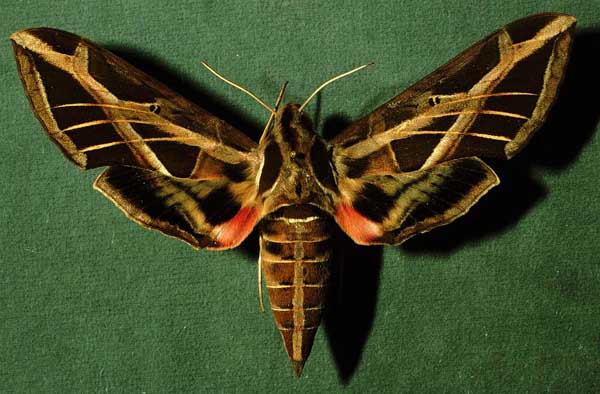
Eumorpha vitis vitis female courtesy of Dan Janzen.
This site has been created by Bill Oehlke.
Comments, suggestions and/or additional information are welcomed by Bill.
| TAXONOMY:
Superfamily: Sphingoidea, Dyar, 1902
Family: Sphingidae, Latreille, 1802
Subfamily: Macroglossinae, Harris, 1839
Tribe: Philampelini, Burmeister
Genus: Eumorpha, Hubner, [1807]
Species: vitis vitis, (Linnaeus, 1758) |
DISTRIBUTION:
The Vine sphinx Moth, (Eumorpha vitis vitis), wingspan 3 3/8 - 4 1/8 inches
(8.5 - 10.5 cm), flies from Argentina north through Central America,
the West Indies, and Mexico to southern Arizona,
Texas, Mississippi, and Florida. Occasionally strays are taken as far
north as Nebraska.
Argentina: Buenos Aires (Dec.), Cordoba,
Formosa, La Rioja, Sante Fe (Sept.), Formosa, Rio Negro, La Rioja, Chaco (EB), Tucuman, Salta (405m EB); Entre Rios (JRR);
Bolivia: Santa Cruz: Ichilo, Buena Vista, Florida, Pampa Grande,
Sarah, Warnes (350-750m);
Brazil; Para: Tucurui (ER); Maranhao (MMN); Ceara: Meruoca (AN); Goias: Aruana (KR); Rio Grande do Norte: Extremoz (FO); Gravatai, Rio Grande do Sul (PRH);
Colombia;
Ecuador: Loja (BF);
Peru: Ica (PD);
French Guiana: Starbroek market area, Georgetown;
Guyana;
Paraguay: Alto Paraguay, Boqueron, Presidente Hayes,
Asuncion, Concepcion, Amambay, San Pedro, Canindeyu, Cordillera, Central, Guaira,
Caaguazu, Paraguari;
Suriname;
Uruguay;
Venezuela.
Mexico: Yucatan: Chichen Itza (Ernesto Alvarado Reyes); and elsewhere;
Belize: Corozol, Cayo, Stann Creek, Toledo;
Guatemala: Izabal (JM);
Honduras: Atlantida, Cortes, Francisco-Morazan;
Nicaragua: Madriz, Esteli, Matagalpa, Chinandega, Leon,
Managua, Granada, Zelaya, Rio San Juan;
Costa Rica: Guanacaste, Puntarenas, Limon,
Heredia, Alajuela, Cartago, San Jose;
Panama.
This species also flies throughout the Carribean. It is subspecies hesperidum that flies in Jamaica.
The upperside of the moth is dark pinkish brown. Each forewing has a lighter brown band along the costa, and sharp
pinkish white bands and streaks. The hindwing has a pink patch on the inner margin, but lacks the pink along the outer
margin, distinguishing it from fasciata.
Note the large brown "parallelogram" between lowest
of three striga upwards toward the transverse lines. In E. fasciatus this same area
is very small, almost non-existent.
Eumorpha vitis vitis in typical resting pose courtesy of James Adams. |
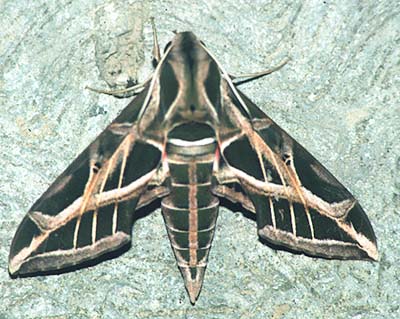 |
"Eumorpha" means well-formed. The species name "vitis" refers to grape as the larval host.
FLIGHT TIMES AND PREFERRED FOOD PLANTS:
There are two broods of Eumorpha vitis vitis in
Florida, from April-May and July-October, but in the northern extent of its range there is a single brood from
July-September. In Costa Rica the moths can be taken in every month of the year.
Sergio Rios Diaz reports March and October flights in Paraguay.
Patrick Demez reports a January flight in southwestern Peru.
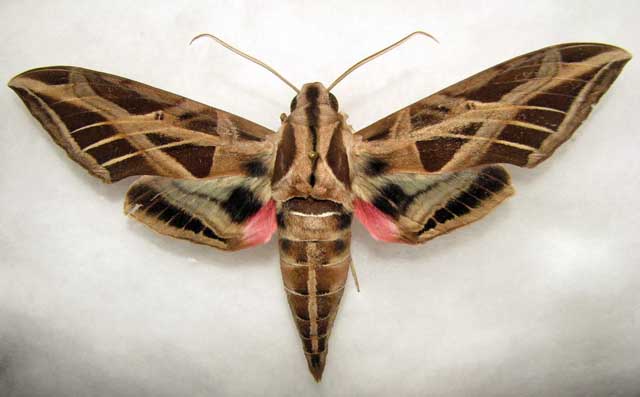
Eumorpha vitis, Ica, Peru, January 23, 2010, courtesy of Patrick Demez.
Magno Marcio Nascimento reports an April flight in Maranhao, Brazil. Andre Netto reports a March 7, 2018, flight in Meruoca, Ceara, Brazil.
At dusk, adults begin nectaring at various flowers, including rosy periwinkle (Vinca rosea), and perhaps orchids in the tropics.
Eumorpha vitis vitis larvae feed upon grape foliage (Vitis) and other vines (Cissus): Cissus pseudosicyoides and Cissus rhombifolia and
Cissus sicycoides.
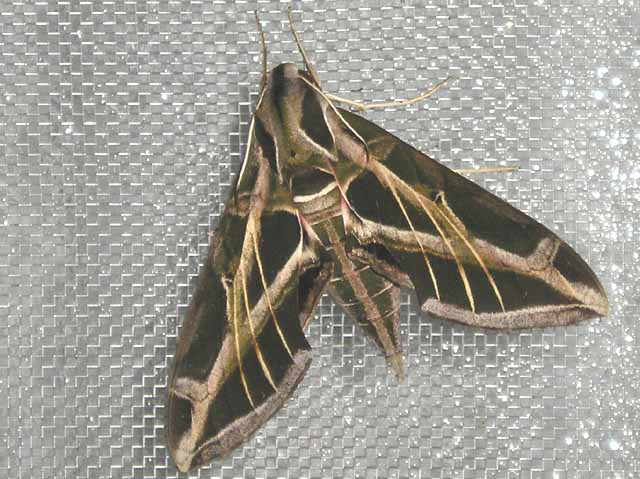
Eumorpha vitis, Chichen Itza, Yucatan, Mexico,
July 12, courtesy of Jean-Marc Pilliere.
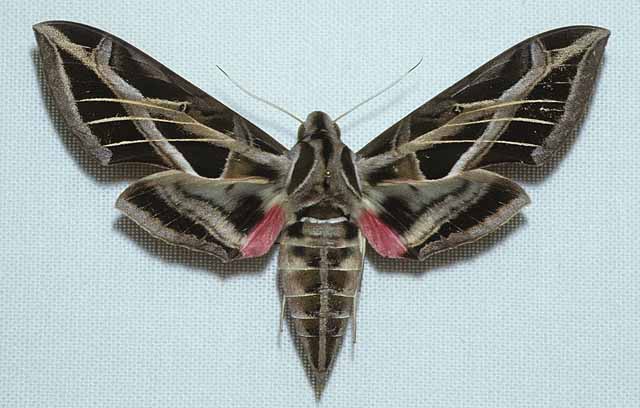
Eumorpha vitis, courtesy of Hubert Mayer
copyright.
Visit stunning image of male
Eumorpha vitis male, Laredo, Webb County, Texas, courtesy of Ricardo Santos.
Visit Eumorpha vitis, Brownsville, Cameron County, Texas, September 27, 2009,
courtesy of Gus A. Rentfro.
Visit Eumorpha vitis, Austin, Texas, June 30, 2010, courtesy of Michelle Walden.
Visit Eumorpha vitis, Rollingwood, Travis County, Texas, August 30, 2012, Deborah Wilson.
Visit Eumorpha vitis Matoes, Maranhao, Brazil, April 2, 2016, Magno Marcio Nascimento.
Visit Eumorpha vitis (recto and verso) Extremoz, Rio Grande do Norte, Brazil, August 23, 2016, Francierlem Oliveira.
ECLOSION, SCENTING AND MATING:
Pupae wiggle to surface just prior to eclosion. Females call at night,
and males (below) fly into the wind to pick up and track the pheromone plume.
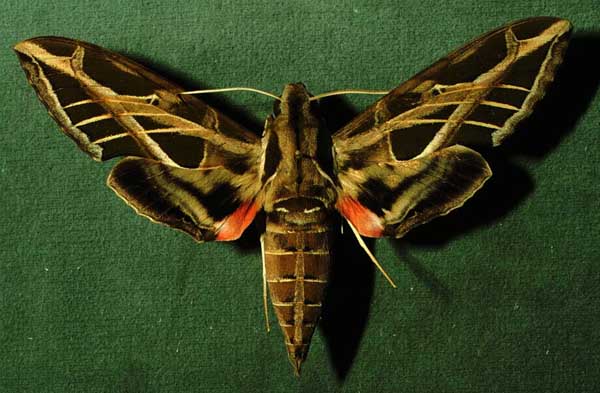
Eumorpha vitis vitis male courtesy of Dan Janzen.
EGGS, LARVAE AND PUPAE:
Larvae exist as either green, yellow or purple colour morphs and pupate in subterranean
burrows. The larva to the right shows damage from tachinid and ichneumonid fly larvae.
Note the four-five smooth lateral stripes with the final one widened as opposed to the six segmented stripes on the Achemon Sphinx larva.
The head is retracted when the larva senses danger. |
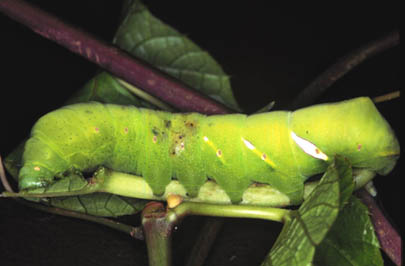 |
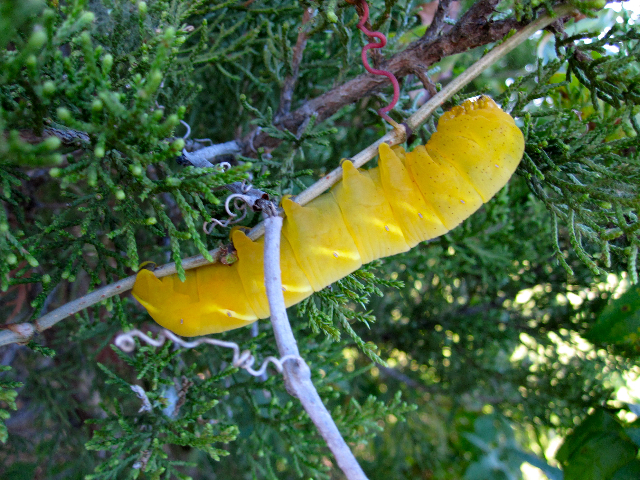
Eumorpha vitis fifth instar,
near Whitney, Hill County, Texas,
courtesy of Donna Sims, via of Lacey L. Ogburn.
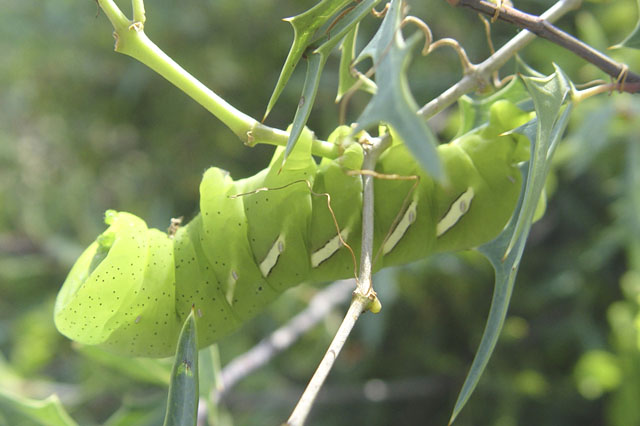
Eumorpha vitis, Austin, Texas, September 19, 2005, courtesy of Melody Lytle.
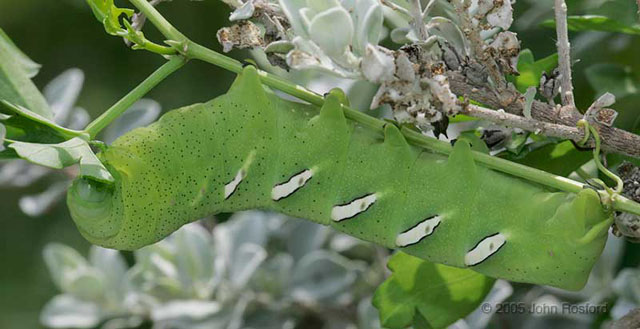
Eumorpha vitis, October 27, 2005, NABA International Butterfly Garden,
Hidalgo County, Texas, courtesy of John Rosford.
Jim Tuttle, who confirmed the id, writes, "Yes, it is vitis. In satellitia the white panels are completely enclosed in black whereas
in vitis the ends of the black panels remain open. Also, satellitia has a faint subdorsal longitudinal stripe that touches the top of
the white panels that is lacking in vitis." As a postscript Jim adds, "The host plant is commonly called sorrel vine (Cissus)."
Visit Eumorpha vitis fourth and fifth instars, Converse, Bexar County,
November 2008, courtesy of Lisa Tingle.
Larval Food Plants
Listed below are primary food plant(s) and alternate food plants. It is hoped that this alphabetical listing followed by the common name of the foodplant will
prove useful. The list is not exhaustive. Experimenting with closely related foodplants is worthwhile.
Cissus incisa
Cissus pseudosicyoides......
Cissus rhombifolia
Cissus sicycoides
Cissus verticillata
Ludwigia decurrens
Ludwigia erecta
Magnolia virginiana
Parthenocissus
Vitis vinifera
| Possum Grape
Cissus pseudosicyoides
Grape and Oak Leaf Ivy
Cissus sicycoides
Seasonvine
Upright
Primrose Willow
Yerba de jicotea
Sweetbay magnolia/Swamp magnolia
Virginia creeper
Grape
|
Visit Emorpha vitis vitis additional images.
Return to U. S. A. Table
Return to Philampelini Index
Return to Sphingidae Index
Use your browser "Back" button to return to the previous page.
This page is brought to you by Bill Oehlke and the
WLSS. Pages are on space rented from Bizland. If you would like to become a "Patron of the Sphingidae Site", contact Bill.
Please send sightings/images to Bill. I will do my best to respond to requests for identification help.
Enjoy one of nature's wonderments: Live Saturniidae (Giant Silkmoth) cocoons.
 | 
Show appreciation for this site by clicking on flashing butterfly to the left.
The link will take you to a page with links to many insect sites. |











